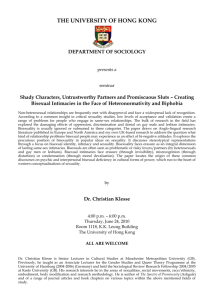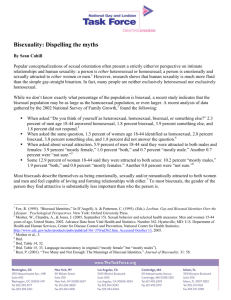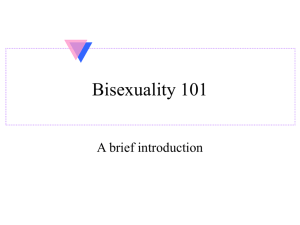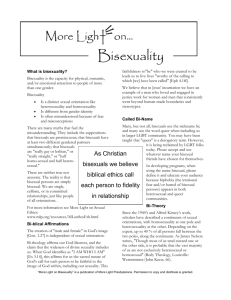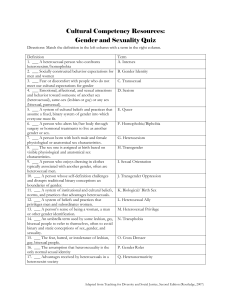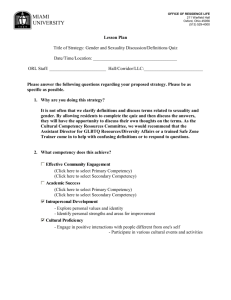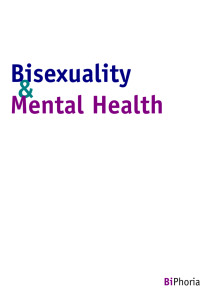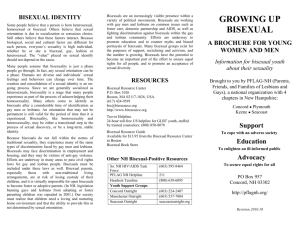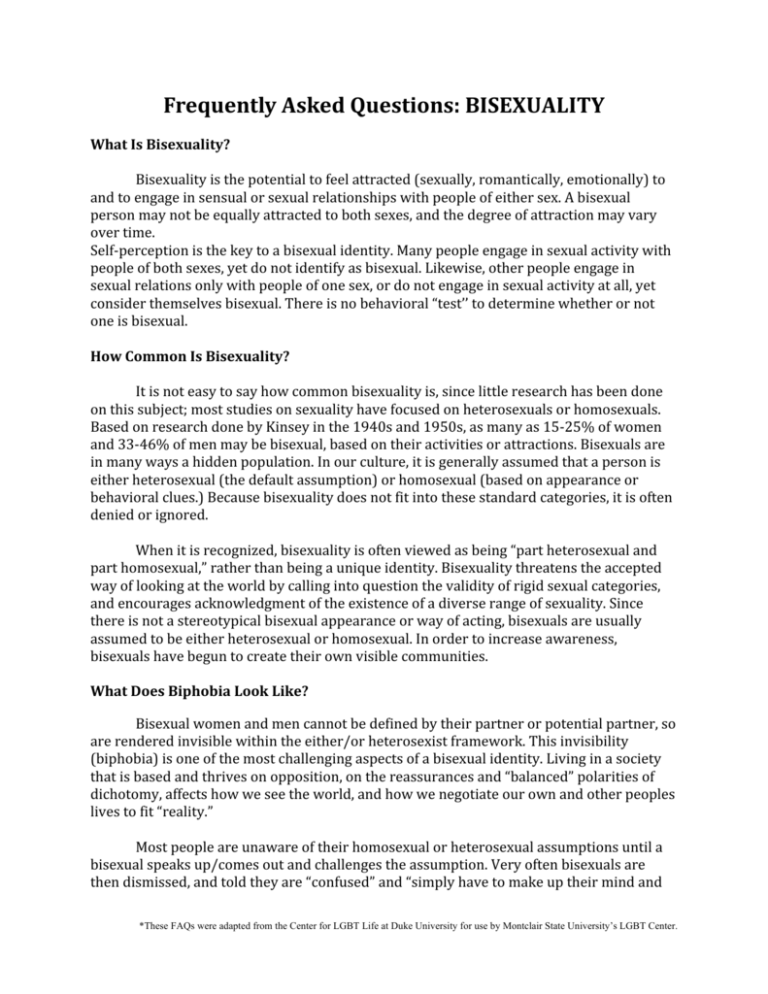
Frequently Asked Questions: BISEXUALITY What Is Bisexuality? Bisexuality is the potential to feel attracted (sexually, romantically, emotionally) to and to engage in sensual or sexual relationships with people of either sex. A bisexual person may not be equally attracted to both sexes, and the degree of attraction may vary over time. Self‐perception is the key to a bisexual identity. Many people engage in sexual activity with people of both sexes, yet do not identify as bisexual. Likewise, other people engage in sexual relations only with people of one sex, or do not engage in sexual activity at all, yet consider themselves bisexual. There is no behavioral “test’’ to determine whether or not one is bisexual. How Common Is Bisexuality? It is not easy to say how common bisexuality is, since little research has been done on this subject; most studies on sexuality have focused on heterosexuals or homosexuals. Based on research done by Kinsey in the 1940s and 1950s, as many as 15‐25% of women and 33‐46% of men may be bisexual, based on their activities or attractions. Bisexuals are in many ways a hidden population. In our culture, it is generally assumed that a person is either heterosexual (the default assumption) or homosexual (based on appearance or behavioral clues.) Because bisexuality does not fit into these standard categories, it is often denied or ignored. When it is recognized, bisexuality is often viewed as being “part heterosexual and part homosexual,” rather than being a unique identity. Bisexuality threatens the accepted way of looking at the world by calling into question the validity of rigid sexual categories, and encourages acknowledgment of the existence of a diverse range of sexuality. Since there is not a stereotypical bisexual appearance or way of acting, bisexuals are usually assumed to be either heterosexual or homosexual. In order to increase awareness, bisexuals have begun to create their own visible communities. What Does Biphobia Look Like? Bisexual women and men cannot be defined by their partner or potential partner, so are rendered invisible within the either/or heterosexist framework. This invisibility (biphobia) is one of the most challenging aspects of a bisexual identity. Living in a society that is based and thrives on opposition, on the reassurances and “balanced” polarities of dichotomy, affects how we see the world, and how we negotiate our own and other peoples lives to fit “reality.” Most people are unaware of their homosexual or heterosexual assumptions until a bisexual speaks up/comes out and challenges the assumption. Very often bisexuals are then dismissed, and told they are “confused” and “simply have to make up their mind and *These FAQs were adapted from the Center for LGBT Life at Duke University for use by Montclair State University’s LGBT Center.
choose.” For bisexually identified people to maintain their integrity in a homo‐hating heterosexist society, they must have a strong sense of self, and the courage and conviction to live their lives in defiance of what passes for “normal.” Some examples of Biphobia include: • Assuming that everyone you meet is either heterosexual or homosexual. • Expecting a bisexual person to identify as heterosexual when coupled with the “opposite” gender/sex. • Believing bisexual men spread AIDS/HIV and other STDs to heterosexuals. • Thinking bisexual people haven’t made up their minds. • Automatically assuming romantic couplings of two women are lesbian, or two men are gay, or a man and a woman are heterosexual. • Expecting bisexual people to get services, information and education from heterosexual service agencies for their “heterosexual side” and then go to gay and/or lesbian service agencies for their “homosexual side” • Using the terms “phase” or “stage” or “confused” or “fence‐sitter” or “bisexual” or “AC/DC” or “switchhitter” as slurs or in an accusatory way. • • Looking at a bisexual person and automatically thinking of their sexuality rather than seeing them as a whole, complete person. • Assuming that bisexuals, if given the choice, would prefer to be within an “opposite” gender/sex coupling to reap the social benefits of a “heterosexual” pairing. • Thinking that bisexual people will have their rights when lesbian and gay people win theirs. • Thinking that people identify as bisexual because it’s “trendy.” • Expecting a bisexual person to identify as gay or lesbian when coupled with the “same” sex/gender. • Avoid mentioning to friends that you are involved with a bisexual or working with a bisexual group because you are afraid they will think you are a bisexual. What does a bisexual relationship usually mean? Bisexuals, like all people, have a wide variety of relationship styles. Contrary to common myth, a bisexual person does not need to be sexually involved with both a man and a woman simultaneously. In fact, some people who identify as bisexual never engage in sexual activity with one or the other (or either) gender. As is the case for heterosexuals and gay men and lesbians, attraction does not involve acting on every desire. Like heterosexuals and gay people, many bisexuals choose to be sexually active with one partner only, and have long‐term, monogamous relationships. Other bisexuals may have open marriages that allow for relationships with same‐sex partners, threeway relationships, or a number of partners of the same or other gender (singly or simultaneously). It is important to have the freedom to choose the type of sexual and affectional relationships that are right for the people involved, whatever their orientation. *These FAQs were adapted from the Center for LGBT Life at Duke University for use by Montclair State University’s LGBT Center.


